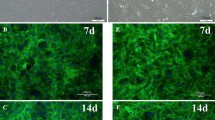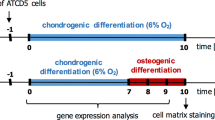Abstract
The formation of the skeleton through endochondral ossification is one of the most complex processes in development. One approach to resolving this complexity is to examine simplified systems. In vitro cartilage formation by mesenchymal stem cells (MSCs) is observed when the cells are cultured as a micromass. Several studies have confirmed the molecular events, showing the usefulness of these cells as a differentiation model. We have elucidated the process of cartilage formation in MSCs from the morphological point of view by light and transmission electron microscopy and immunohistochemical examination. The morphology of the MSCs changed from spherical to spindle-shaped, and the cells aggregated and formed junctional complexes during Day 1. At Day 7, three layers were observed. The superficial zone consisted of several layers of elongated cells with junctional complexes. The middle zone was composed of apoptotic bodies, and the deep zone was occupied by chondrocyte-like cells excreting extracellular matrices. At Day 14, the middle zone had disappeared, and the chondrocyte-like cells in the deep zone were detected within cartilage lacuna. They were covered by cartilage matrices containing collagen types I, II, and X and chondroitin sulfate. By Day 21, the outer layer consisting of spindle-shaped cells had disappeared in places. As the pellet grew, the outer layer seemed to be unable to stretch to maintain a constant covering around the pellet. Our findings have thus revealed that MSCs change their morphology depending upon their microenvironment during differentiation. In vitro cartilage formation by MSCs makes it possible to clarify the detailed morphological events that occur during chondrogenesis.









Similar content being viewed by others
References
Ashton BA, Allen TD, Howlett CR, Eaglesom CC, Hattori A, Owen M (1980) Formation of bone and cartilage by marrow stromal cells in diffusion chambers in vivo. Clin Orthop 313:294–307
Bendayan M, Roth J, Perrelet A, Orci L (1980) Quantitative immunocytochemical localization of pancreatic secretory proteins in subcellular compartments of the rat acinar cell. J Histochem Cytochem 28:149–160
DeLise AM, Fischer L, Tuan RS (2000) Cellular interactions and signaling in cartilage development. Osteoarthr Cartil 8:309–334
Edelman GM (1986) Cell adhesion molecules in the regulation of animal form and tissue pattern. Annu Rev Cell Biol 2:81–116
Eskelinen E-L, Illert AL, Tanaka Y, Schwarzmann G, Blanz J, Figura K, Saftig P (2002) Role of LAMP-2 in lysosome biogenesis and autophagy. Mol Biol Cell 13:3355–3368
Fell HB (1925) The histogenesis of cartilage and bone in the long bones of the embryonic fowl. J Morphol 40:417–451
Ichinose S, Muneta T, Aoki H, Tagami M (2003a) TEM observation of seven retrieved total knee joints made of Co-Cr-Mo and Ti-Al-V alloys. Biomed Mater Eng 13:125–134
Ichinose S, Muneta T, Sekiya I, Itoh S, Aoki H, Tagami M (2003b) The study of metal ion release and cytotoxicity in Co-Cr-Mo and Ti-Al-V alloy in total knee prosthesis—scanning electron microscopic observation. J Mater Sci Mater Med 14:79–86
Imabayashi H, Mori T, Gojo S, Kiyono T, Sugiyama T, Irie R, Isogai T, Hata J, Toyama Y, Umezawa A (2003) Redifferentiation of dedifferentiated chondrocytes and chondrogenesis of human bone marrow stromal cells via chondrosphere formation with expression profiling by large-scale cDNA analysis. Exp Cell Res 288:35–50
Ishitani T, Ninomiya-Tsuji J, Nagai S, Nishita M, Meneghini M, Barker N, Waterman M, Bowerman B, Clevers H, Shibuya H, and Matsumoto K (1999) The TAK1-NLK-MAPK-related pathway antagonizes signalling between beta-catenin and transcription factor TCF. Nature 399:798–802
Ito MM, Kida MY (2000) Morphological and biochemical re-evaluation of the process of cavitation in the rat knee joint: cellular and cell strata alterations in the interzone. J Anat 197:659–679
Johnstone B, Hering TM, Caplan AI, Goldberg VM, Yoo JU (1998) In vitro chondrogenesis of bone marrow-derived mesenchymal progenitor cells. Exp Cell Res 238:265–272
Lefebvre V, de Crombrugghe B (1998) Toward understanding SOX9 function in chondrocyte differentiation. Matrix Biol 16:529–540
Mackay AM, Beck SC, Murphy JM, Barry FP, Chichester CO, Pittenger MF (1998) Chondrogenic differentiation of cultured human mesenchymal stem cells from marrow. Tissue Eng 4:415–428
Matsuda S, Mishima K, Yoshimura Y, Hatta T, Otani H(1997) Apoptosis in the development of the temporomandibular joint. Anat Embryol 196:383–391
Meneghini MD, Ishitani T, Carter JC, Hisamoto N, Ninomiya-Tsuji J, Thorpe CJ, Hamill DR, Matsumoto K, Bowerman B (1999) MAP kinase and Wnt pathways converge to downregulate an HMG-domain repressor in Caenorhabditis elegans. Nature 399:793–797
Oberlender SA, Tuan RS (1994) Expression and functional involvement of N-cadherin in embryonic limb chondrogenesis. Development 120:177–187
Pevny LH, Lovell-Badge R (1997) Sox genes find their feet. Curr Opin Genet Dev 7:338–344
Pittenger MF, Mackay AM, Beck SC, Jaiswal RK, Douglas R, Mosca JD, Moorman MA, Simonetti DW, Craig S, Marshak DR (1999) Multilineage potential of adult human mesenchymal stem cells. Science 284:143–147
Prockop DJ (1997) Marrow stromal cells as stem cells for nonhematopoietic tissues. Science 276:71–74
Sakaguchi Y, Sekiya I, Yagishita K, Ichinose S, Shinomiya K, Muneta T (2004) Suspended cells from trabecular bone by collagenase digestion become virtually identical to mesenchymal stem cells obtained from marrow aspirates. Blood 104:2728–2735
Sekiya I, Tsuji K, Koopman P, Watanabe H, Yamada Y, Shinomiya K, Nifuji A, Noda M (2000) SOX9 enhances aggrecan gene promoter/enhancer activity and is up-regulated by retinoic acid in a cartilage-derived cell line, TC6. J Biol Chem 275:10738–10744
Sekiya I, Colter DC, Prockop DJ (2001) BMP-6 enhances chondrogenesis in a subpopulation of human marrow stromal cells. Biochem Biophys Res Commun 284:411–418
Sekiya I, Vuoristo JT, Larson BL, Prockop DJ (2002) In vitro cartilage formation by human adult stem cells from bone marrow stroma defines the sequence of cellular and molecular events during chondrogenesis. Proc Natl Acad Sci U S A 99:4397–4402
Sekiya I, Larson BL, Vuoristo JT, Reger RL, Prockop DJ (2005) Comparison of effect of BMP-2, -4, and -6 on in vitro cartilage formation of human adult stem cells from bone marrow stroma. Cell Tissue Res 320:269–276
Shibuya H, Yamaguchi K, Shirakabe K, Tonegawa A, Gotoh Y, Ueno N, Irie K, Nishida E, Matsumoto K (1996) TAB1: an activator of the TAK1 MAPKKK in TGF-beta signal transduction. Science 272:1179–1182
Summerbell D, Wolpert L (1972) Cell density and cell division in the early morphogenesis of the chick wing. Nat New Biol 239:24–26
Tagami M, Ichinose S, Yamagata K, Fujino H, Shoji S, Hiraoka M, Kawano S (2003) Genetic and ultrastructural demonstration of strong reversibility in human mesenchymal stem cell. Cell Tissue Res 312:31–40
Tokuyasu KT (1986) Application of cryoultramicrotomy to immunocytochemistry. J Microsc 143:139–149
Wagner T, Wirth J, Meyer J, Zabel B, Held M, Zimmer J, Pasantes J, Bricarelli FD, Keutel J, Hustert E, et al (1994) Autosomal sex reversal and campomelic dysplasia are caused by mutations in and around the SRY-related gene SOX9. Cell 79:1111–1120
Werner MH, Burley SK (1997) Architectural transcription factors: proteins that remodel DNA. Cell 88:733–736
Wright E, Hargrave MR, Christiansen J, Cooper L, Kun J, Evans T, Gangadharan U, Greenfield A, Koopman P (1995) The Sry-related gene Sox9 is expressed during chondrogenesis in mouse embryos. Nat Genet 9:15–20
Yokota S, Tsuji H, Kato K (1984) Localization of lysosomal and peropxisomal enzymes in the specific granules of rat intestinal eosinophil leukocytes revealed by immunoelectron microscopic techniques. J Histochem Cytochem 32:267–274
Yoo JU, Barthel TS, Nishimura K, Solchaga L, Caplan AI, Goldberg VM, Johnstone B (1998) The chondrogenic potential of human bone-marrow-derived mesenchymal progenitor cells. J Bone Joint Surg Am 80:1745–1757
Acknowledgements
The authors thank Yusuke Sakaguchi and Izumi Nakagawa for help with the cell cultures, Miyoko Ojima for help with the immunostaining, Masako Kawano and Kumiko Takeda for technical assistance, and Alexandra Peister for proofreading.
Author information
Authors and Affiliations
Corresponding author
Additional information
S. Ichinose and I. Sekiya contributed equally to this study
Rights and permissions
About this article
Cite this article
Ichinose, S., Tagami, M., Muneta, T. et al. Morphological examination during in vitro cartilage formation by human mesenchymal stem cells. Cell Tissue Res 322, 217–226 (2005). https://doi.org/10.1007/s00441-005-1140-6
Received:
Accepted:
Published:
Issue Date:
DOI: https://doi.org/10.1007/s00441-005-1140-6




